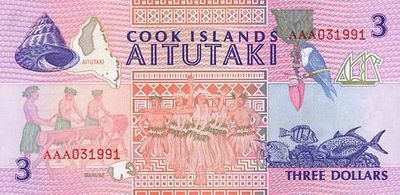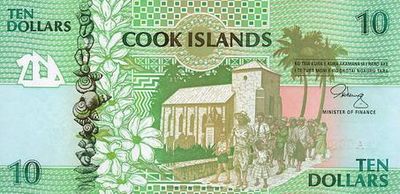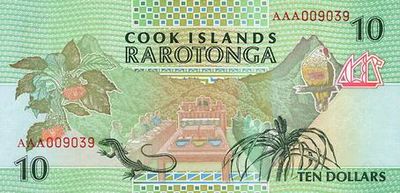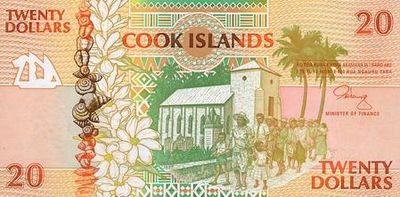Cook Islands dollar facts for kids
Quick facts for kids Cook Islands dollar |
|||
|---|---|---|---|
|
|||
| ISO 4217 Code | NZD | ||
| User(s) | |||
| Inflation | 2.1% | ||
| Source | The World Factbook, 2005 est. | ||
| Pegged with | New Zealand dollar at par | ||
| Subunit | |||
| 1⁄100 | cent / tene | ||
| Symbol | $ | ||
| cent / tene | c | ||
| Coins | 10c, 20c, 50c, $1, $2, $5 | ||
| Banknotes | $3, $10, $20, $50 | ||
| Printer | De La Rue | ||
The Cook Islands dollar was the money used in the Cook Islands for a time. Today, people there mostly use the New Zealand dollar. However, some of the old Cook Islands dollar coins and notes are still used. This money was divided into 100 cents. Some older 50-cent coins even said "50 tene" on them, which is the local word for cent.
History of the Cook Islands Dollar
Before 1967, the Cook Islands used the New Zealand pound. Then, the New Zealand dollar took its place.
In 1972, the Cook Islands started making their own special coins. These coins were still part of the New Zealand dollar system.
In 1987, the Cook Islands dollar was officially created. It was linked to the New Zealand dollar, meaning one Cook Islands dollar was worth one New Zealand dollar. The government promised to keep enough New Zealand dollars to back up their own money. The New Zealand dollar could still be used alongside the new Cook Islands dollar.
Over time, the government changed how much New Zealand money was needed to back up the Cook Islands dollar. By 1993, the $3 notes only had 5% of their value backed by New Zealand dollars. Coins had no backing at all.
The government was printing more money and spending more than it earned. This led to a big national debt, which means the country owed a lot of money. Banks eventually stopped exchanging Cook Islands dollars for New Zealand dollars. This caused an economic problem. Because of this, the government decided to go back to using only the New Zealand dollar in April 1995. Most Cook Islands dollar banknotes stopped being official money, but the $3 note and all the coins could still be used.
Many of the Cook Islands coins were made by the Royal Australian Mint. The paper money was printed by De La Rue in England.
Cook Islands Coins
In 1972, the Cook Islands introduced coins in different values. These included 1 and 2-cent coins made of bronze, and 5, 10, 20, and 50-cent coins, plus a 1-dollar coin, made of a silver-colored metal called cupro-nickel. These coins were similar in size and weight to New Zealand coins. The 1-dollar coin was quite large and popular. Each coin showed unique plants, animals, or items from the Cook Islands.
In 1983, they stopped making 1 and 2-cent coins. These coins were later taken out of use.
The Cook Islands are known for their interesting and unusual coins. For example, they were one of the last places to use large 1-dollar coins for everyday use.
In 1987, a smaller, lighter $1 coin was made. It had a wavy, scallop-edged shape. That same year, the Cook Islands became the first modern country to make a triangular $2 coin for regular use! They also made a twelve-sided $5 coin.
In 1988, the 50-cent coin was redesigned. It was the first coin to show its value in the local language, "tene," instead of "cents."
When the Cook Islands dollar was stopped in 1995, the local coins stayed in use. They were then worth New Zealand dollars. New coins continued to be made with "Cook Islands" written on them.
In 2000, a large 5-cent coin was made from stainless steel. It showed Tangaroa, a Polynesian sea god.
In 2003, a 1-cent coin was brought back. This time, it was made of aluminum. These coins had five different pictures on the back, celebrating the nation's history.
In 2015, new coins were made. The 10, 20, and 50-cent coins are now made of nickel-plated steel. The 1, 2, and 5-dollar coins are made of brass-plated steel. The new 5-dollar coin shows a traditional vaka (a type of canoe). These new coins are smaller and closer in size to New Zealand's coins.
On April 30, 2016, all the older coins were taken out of use.
All Cook Islands coins show Queen Elizabeth II on one side. She was the Head of State.
The other side of the standard coins shows different designs:
| Value | Diameter | Composition | 1972–2010 | |
|---|---|---|---|---|
| Obverse | Reverse | |||
| 1 cent | 18 mm | Bronze | Queen | Taro leaf |
| 2 cents | 21 mm | Queen | Pineapples | |
| 5 cents | 19 mm | Cupronickel | Queen | Hibiscus blossom |
| 10 cents | 24 mm | Queen | Orange on branch | |
| 20 cents | 29 mm | Queen | Fairy tern | |
| 50 cents | 32 mm | Queen | Bonito (1972–87; also 1992) Sea turtle (1988–94) |
|
| 1 dollar | 30 mm | Queen | Tangaroa, sea god in Māori mythology | |
| 2 dollars | 27/27/27 mm | Queen | Mortar and pestle | |
| 5 dollars | 33 mm | Nickel-brass | Queen | Pacific Triton Conch |
Here are the designs for the 2015 coins:
| Value | Diameter | Composition | 2015 | |
|---|---|---|---|---|
| Obverse | Reverse | |||
| 10 cents | 19 mm | Nickel-plated steel | Queen | Orange on branch |
| 20 cents | 21 mm | Queen | Fairy tern | |
| 50 cents | 24.2 mm | Queen | Albacore Tuna | |
| 1 dollar | 28.52 mm | Brass-plated steel | Queen | Tangaroa, sea god in Māori mythology |
| 2 dollars | 26 mm | Queen | Mortar and pestle | |
| 5 dollars | 33 mm | Queen | Vaka | |
The Cook Islands also makes many special collector coins. These coins are not meant for everyday use. They are made to raise money for the government.
Cook Islands Banknotes
On July 20, 1987, the government introduced 3, 10, and 20-dollar notes. In 1992, new 50-dollar notes were added. All these notes show pictures of things important to the local Polynesian culture.
In June 1995, the Cook Islands government started exchanging most of its banknotes for New Zealand money. However, the 3-dollar note and all the coins continued to be used.
In 2015, the Cook Islands government sold its remaining stock of Cook Islands banknotes.
On August 4, 2021, a new 3-dollar banknote was released. This new note is made from polymer, which is a type of plastic.
Here are the 1987 series banknotes:
| 1987 Series | ||
|---|---|---|
| Value | Obverse | Reverse |
| $3 | ||
| $10 | ||
| $20 | ||
Here are the 1992 series banknotes:
| 1992 Series | ||
|---|---|---|
| Value | Obverse | Reverse |
| $3 |  |
 |
| $10 |  |
 |
| $20 |  |
 |
| $50 | ||
Here is the 2021 series banknote:
| 2021 Series | ||
|---|---|---|
| Value | Obverse | Reverse |
| $3 | ||
See also
- Economy of the Cook Islands
- New Zealand dollar
- Niue dollar
- Pitcairn Islands dollar




